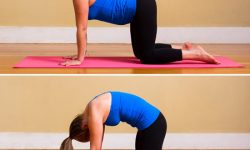When I was really ill, there were many days I could barely get out of bed. My workouts included getting dressed and microwaving a meal. I hadn’t discovered yoga yet, though it had been recommended to me. The classes I saw at my local studio were way beyond my limits. So I stayed in bed watching TV or reading, wondering if I was ever going to get better. I missed being able to swim, or play volleyball, or just walk into town with my friends or go to the shop like a normal person. Not only did it suck that I couldn’t do any of those things, but my muscles were weakening and my stamina waning. I tried to do gentle muscle strengthening exercises on my better days, but I couldn’t always do them and didn’t feel like I was making much progress.
What I wish I had known then, is that researchers have found the mind is way more powerful than we think. Imagining, or visualising doing exercises, can have almost as much positive effect on our bodies as actually doing the exercise. Numerous studies have found that, to varying degrees, visualising a workout increases muscles strength. This is really hopeful news for anyone living with or recovering from a chronic illness. If you are bed bound, recovering in hospital, or just having a bad day, the right visualisation strategy can stop your muscles from deteriorating.
“Of course it is happening inside your head, Harry, but why on earth should that mean that it is not real?”
― J.K. Rowling, Harry Potter and the Deathly Hallows (dancing with glee that I found a place to use a Harry Potter quote on this blog)
Athletes have been using this visualisation thing for a long time. I remember getting told off at swim meets for hanging out with my friends instead of ‘visualising’ my race. Our coaches used the visualisation technique as a tool to get in the right mindset, but athletes also use it to train during their rest days.
How much can visualisation actually benefit you?
While all of the studies I read found that visualisation had a physical benefit to the people who practiced it, the numbers varied from study to study. Ranging from being 35% to %85 as effective as doing the physical exercise. The highest benefit was found when participants did both mental and physical training. The people practicing visualisation had a much higher benefit than the people who sat around and did nothing. Even though they basically sat around and did nothing!
When running my yoga course I often get asked how to keep up a regular practice if you are having an ‘off’ day or just can’t muster up the motivation to practice. Visualising doing yoga is an excellent way for people in recovery to get more regular exercise. Even if you’re having an ‘off’ day you can still spend a few minutes imagining yourself exercising, and still get many of the same benefits as if you actually did the practice.
These findings are especially exciting for those of us who are bed-bound or recovering from physical injury. While visualising is never going to be the same as doing the exercise, it’s certainly a great option for people in recovery mode, or who just need a rest day!
The challenge:
Go and listen to this video. Lie on your back and close your eyes. Imagine yourself doing the exercises described in the recording. This means really imagining your muscles moving, rather than watching yourself doing the poses. Try not to accidentally move your muscles as you are doing the visualisation practice.
Once you’ve done it let me know how it went in the comments! How did you feel after the practice? Is it something you could see yourself doing on a regular basis?









1 Response